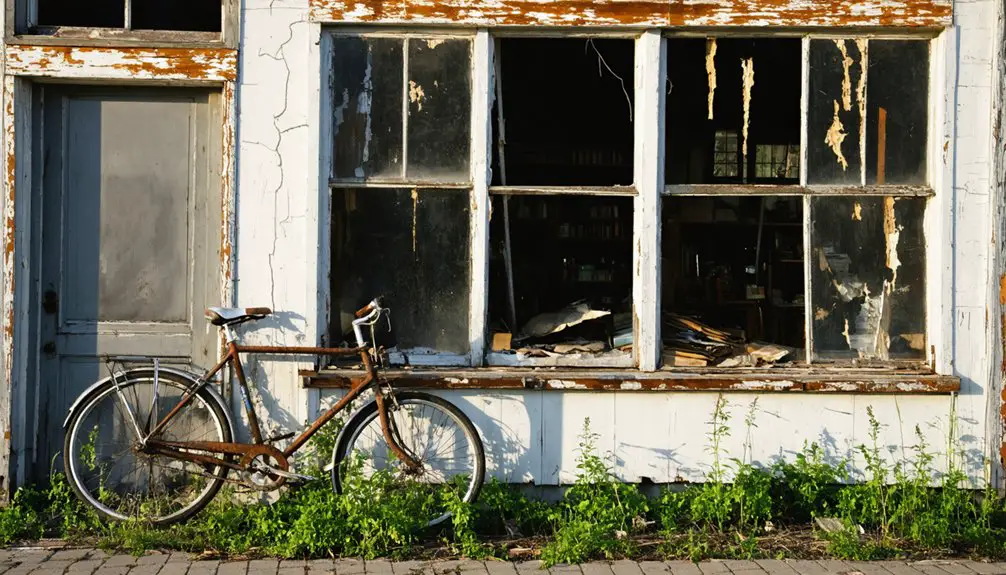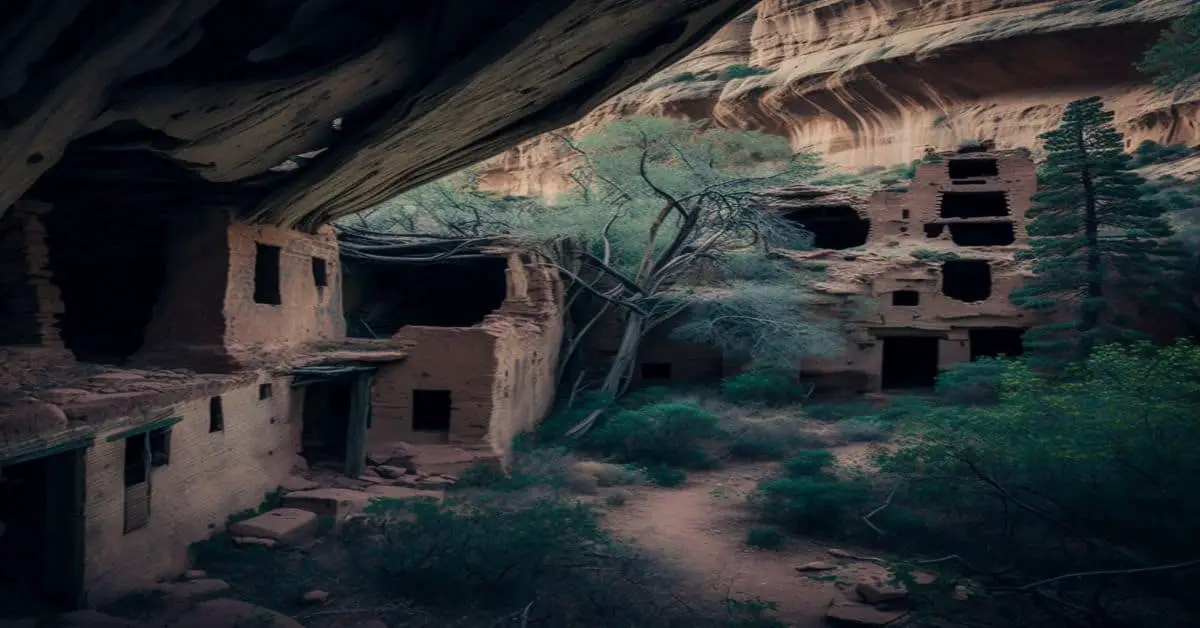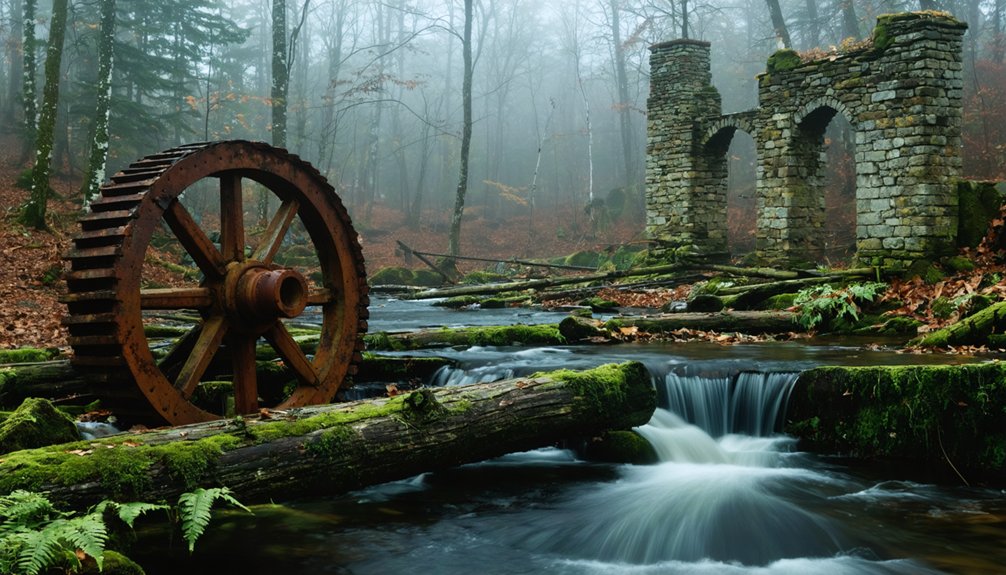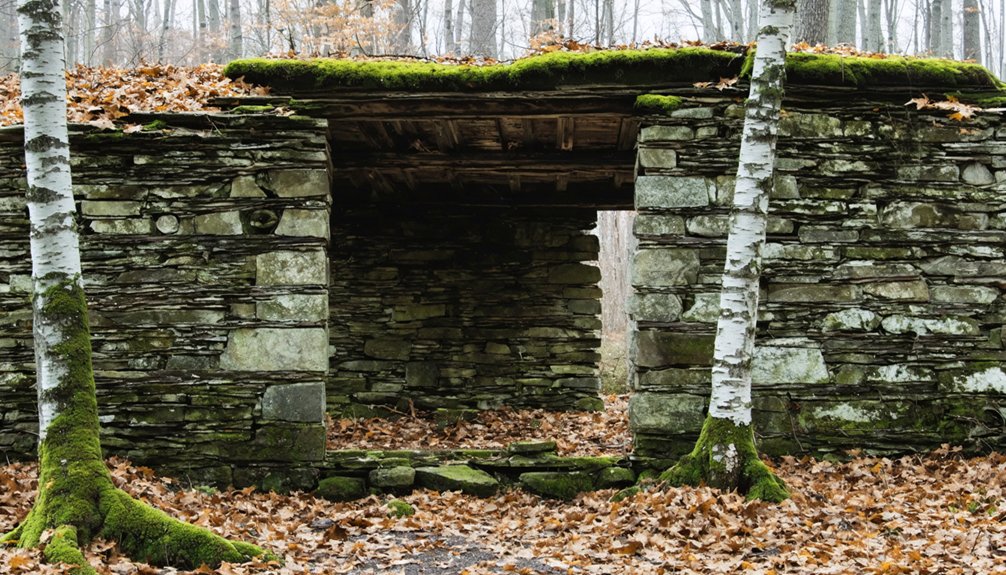You’ll find Haunted Lake’s eerie legacy at the heart of Francestown, New Hampshire, where colonial settlement began in 1736. The lake earned its reputation after David Scoby discovered a mysterious skeleton while building his mill in 1780. Local folklore tells of unexplained groans, tragic drownings, and the notorious Scoby boys’ ghostly pranks. The town’s rich history along the Second New Hampshire Turnpike holds countless untold tales of supernatural encounters and colonial mysteries.
Key Takeaways
- Francestown reached its peak population and prosperity before the Civil War but later experienced significant decline in commerce and residents.
- The Second New Hampshire Turnpike, established in 1800, brought vital commerce and transportation through Francestown before eventual decline.
- Haunted Lake’s supernatural reputation and local ghost stories contributed to the town’s mystique and cultural heritage.
- Early settlers like David Scoby established mills and infrastructure, but tragic events and deaths marked the community’s development.
- The town’s rural traditions and labor-intensive lifestyle shaped its character, with many original structures now standing as historical remnants.
The Birth of a Colonial Settlement
While native peoples used the area primarily as hunting grounds, Francestown’s colonial story began in tandem with neighboring New Boston’s 1736 land grant.
Before European settlement, Native Americans utilized these lands for hunting, until colonial expansion began alongside New Boston in 1736.
You’ll find that early settlements emerged through negotiations with the Masonian Proprietors, who struck deals offering tax-free lots in exchange for land improvements. The early settlers made use of rich grass crops that grew naturally in the drained beaver ponds.
The town’s official birth came in 1772 when colonial governance established Francestown, named after Frances Wentworth Deering, wife of NH Governor John Wentworth.
You might be intrigued to know she caused quite a stir by remarrying just 14 days after being widowed.
This incorporation wasn’t just about a name – it gave the growing community local authority and launched infrastructure development that would shape the town’s future. The town reached its peak prosperity before the Civil War with thriving commerce and a robust population.
Haunted Lake’s Dark Origins
You’ll find Haunted Lake‘s notorious reputation stems from the chilling discovery of a young man’s skeleton by Irish settler David Scoby while building his mill around 1780, reportedly linked to a trapper’s tale of death and hasty burial.
Though the area’s haunted status predated European settlement, the Scoby boys capitalized on these fears in the 1780s by staging elaborate pranks in the dark woods, targeting inebriated locals who wandered too close to the lake.
These teenage troublemakers didn’t create the lake’s eerie reputation – that honor belongs to earlier accounts of strange noises and incidents documented by surveyor Matthew Patten in 1753 – but they certainly helped cement its place in local folklore.
The lake’s dark history continued into the 1800s with tragic drownings, including Jacob Langdell in 1810 who met his fate in the mysterious waters.
Scoby himself would ultimately succumb to the lake’s deadly nature when he died hauling logs across its frozen surface in 1829.
Mysterious Skeleton Discovery
Around 1780, during the construction of his saw and gristmill near Haunted Lake, David Scoby unearthed a chilling discovery – the skeleton of a tall, well-built young man buried in a shallow grave.
The skeleton’s significance raised questions about early burial practices in the area, though it didn’t deter Scoby’s development plans. Today, the small beach area remains a serene yet eerie reminder of this unsettling find. The area’s soapstone quarry deposits, discovered in the 1790s, later became another historical landmark near the mysterious lake.
Local legends offer intriguing possibilities about the skeleton’s identity:
- A trapper’s companion who met his fate while hunting
- A victim of the lake’s mysterious past, predating Scoby’s arrival
- Evidence of the area’s darker history before Francestown’s incorporation
You’ll find it fascinating that even before this grim discovery, the lake already had a spooky reputation dating back to at least 1753, suggesting deeper mysteries lurking beneath its peaceful surface.
Early Trapper’s Fatal Tale
Before the discovery of the mysterious skeleton, a harrowing tale of survival unfolded near what would become known as Haunted Lake.
You’ll find the roots of this dark history in the story of an early trapper who faced the untamed wilderness of 18th century New Hampshire.
After killing a mountain lion, the trapper’s fears of its mate seeking revenge drove him to make a fateful decision.
Having lost his companion to death, he hastily buried the body in a shallow grave and fled to the safety of Dunstable.
This desperate act would later connect to the haunting legacy of Haunted Lake when David Scoby unearthed a skeleton while building his mill.
The lake’s ominous name originates from a fire before 1753 that scarred the surrounding landscape.
The trapper’s tale exemplifies the raw dangers early settlers faced in this unforgiving territory.
Scoby Boys’ Ghost Pranks
While the trapper’s tale set an early tone of dread around Haunted Lake, the Scoby boys’ mischievous pranks in the 1780s deepened its supernatural reputation.
David Scoby’s teenage sons turned the lake’s existing haunted reputation into their personal playground, crafting elaborate ghostly folklore through their nighttime antics. The family’s arrival after the Revolutionary War established their permanent presence in the area.
You’ll find their most notorious Scoby pranks included:
- Creating floating apparitions using burning rags on the water
- Sneaking through woods while rattling chains and groaning
- Targeting drunk locals and travelers with their spooky stunts
You can trace how their shenanigans capitalized on limited entertainment options in colonial Francestown, making the lake even more infamous.
Though the original “Haunted Lake” name predated their arrival, these crafty teens guaranteed its spectral legacy would endure for generations.
Legendary Scoby Family Tales
Deep in the heart of Francestown’s folklore, the Scoby family’s legendary tales have captivated locals since the late 18th century.
You’ll find the most intriguing Scoby legends centered around their pond, where surveyor Matthew Patten documented mysterious groans in 1753. The haunting reputation grew stronger after a chilling tale from 1741, when one traveler allegedly murdered another near the shore, leaving the victim’s spirit to wander the waters.
The family hauntings took a darker turn between 1810 and 1830, as several drownings added to the pond’s eerie legacy.
Despite these unsettling stories, the Scobys remained prominent citizens, their name evolving from Scobey to Scobie while their mill served as the town’s economic backbone. Their Irish immigrant heritage and revolutionary service wove deeply into Francestown’s early American tapestry.
World-Class Soapstone Legacy

In 1794, Daniel Fuller’s chance discovery of soapstone while plowing his Francestown farmland would spark a legacy spanning generations.
You’ll find this deposit remains Earth’s purest, free from flaws that plague lesser sources. The quarry’s soapstone significance grew as innovations transformed operations from simple excavation to industrial-scale production. The Francestown Soapstone Company was officially incorporated in 1865, marking a new era of professional mining operations. The quarry reached an impressive 134 feet deep, rivaling the height of a 13-story building.
Consider these groundbreaking quarry innovations that set Francestown apart:
- 12-horsepower steam engine derrick revolutionized block lifting (1865)
- 20-horsepower steam boiler powered deeper excavation (1882)
- Advanced mill operations produced massive works like the 9-foot bakery oven
Today, you can explore the abandoned quarry site where steam-powered machinery once carved out New England’s first soapstone deposit, a symbol of American industrial ingenuity and the freedom to innovate.
Ghosts, Groans, and Local Lore
You’ll find that Haunted Lake’s eerie reputation predates even the arrival of David Scoby’s mill in 1780, with surveyor Matthew Patten documenting mysterious groans and shrieks near the lake’s outlet in 1753.
The lake’s haunted moniker might’ve stemmed from a devastating fire that left its shores charred and lifeless, though no one knows for certain.
While the Scoby Boys later capitalized on these ghostly tales by creating their own spooky sounds to frighten passersby, they weren’t the original source of the lake’s supernatural associations.
Lake’s Mysterious Origins
While many assume the Scoby boys’ ghostly pranks in the 1780s gave Haunted Lake its name, historical records reveal the eerie title predated their antics by at least three decades.
Early lake folklore tells of mysterious events that shaped the area’s reputation long before the Scobys arrived.
You’ll find three key elements that contributed to the lake’s haunted origins:
- Unexplained phenomena reported by early settlers before 1753
- A tragic tale of two trappers, with one killed by a mountain lion near the shore
- Local ghost stories that circulated among Indigenous peoples and first European settlers
The ghostly phenomena associated with the lake attracted David Scoby to establish his sawmill there in 1780, and his mischievous sons simply capitalized on the existing supernatural reputation.
Scoby Boys’ Ghost Tricks
Through their imaginative pranks and nighttime theatrics, David Scoby’s teenage sons transformed an already eerie location into a legendary haunted hotspot during the late 1700s.
You’d find them lurking in the shadows near their father’s mill at Haunted Lake, where they’d orchestrate elaborate ghostly antics to terrify unsuspecting passersby.
The boys particularly delighted in targeting tipsy locals and amateur ghost hunters, creating spine-chilling scenes with burning rags that appeared to float mysteriously across the pond’s surface.
Their masterful use of rattling chains and blood-curdling groans from the surrounding woods added layers to the local legends that had already taken root.
While the lake’s haunted reputation predated their mischief, the Scoby Boys’ creative pranks guaranteed these supernatural tales would endure for generations.
Life Along the Historic Turnpike
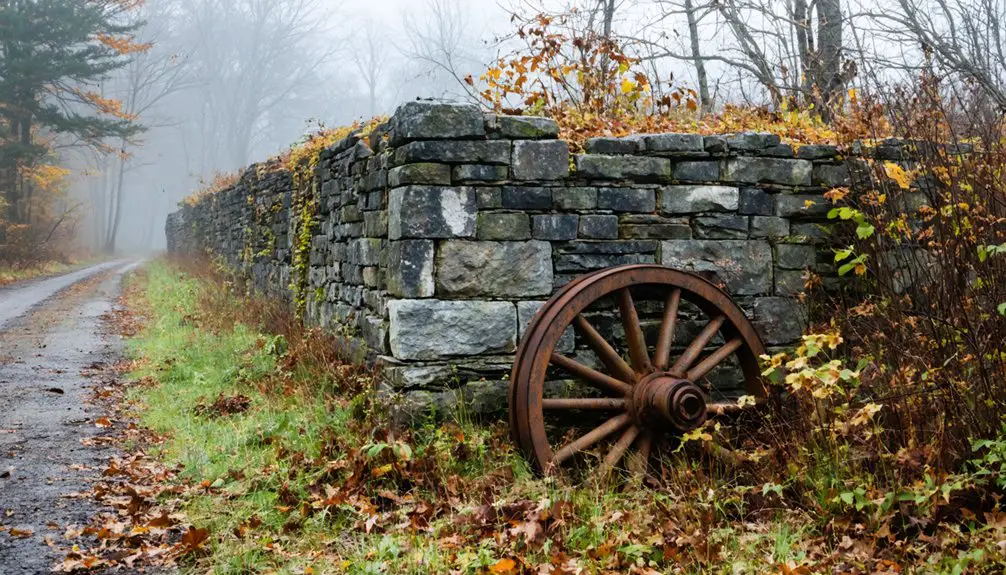
As the Second New Hampshire Turnpike carved its way from Amherst to Claremont in 1800, it transformed Francestown into a bustling hub of commerce and travel.
You’d find yourself paying one cent per mile at toll gates near Avery Road and Gibson Tavern, joining the steady stream of travelers between Boston and Montreal.
Here’s what you’d witness during the turnpike’s heyday:
- Six-horse teams replacing oxen, hauling heavy freight and maneuvering winter routes with specialized double “pungs”
- Massive livestock drives, including the legendary sight of 500 turkeys led by a single commanding gobbler
- Stagecoaches bringing mail, passengers, and news between rural communities and urban markets
The turnpike’s influence ran deep, spawning taverns, inns, and a thriving soapstone industry that defined Francestown’s character until 1912.
Rural Roots and Cultural Heritage
Since its incorporation in 1772, Francestown’s rural character has been shaped by hardy settlers like Irish immigrant David Scoby, who established the town’s first saw and gristmill near Haunted Lake.
You’ll find that rural traditions grew from families living modestly, making their own entertainment and working labor-intensive jobs like woodcutting.
Community folklore flourished around places like Haunted Lake, where ghost stories and legends of mountain lions became woven into the social fabric.
These tales weren’t just entertainment – they reflected the daily lives and experiences of residents who maintained deep genealogical connections to the area’s earliest settlers.
Today, you’ll see how these rural roots persist through historical societies and community efforts, even as newcomers bring different perspectives to the town’s evolving identity.
Natural Wonders and Hidden Mysteries
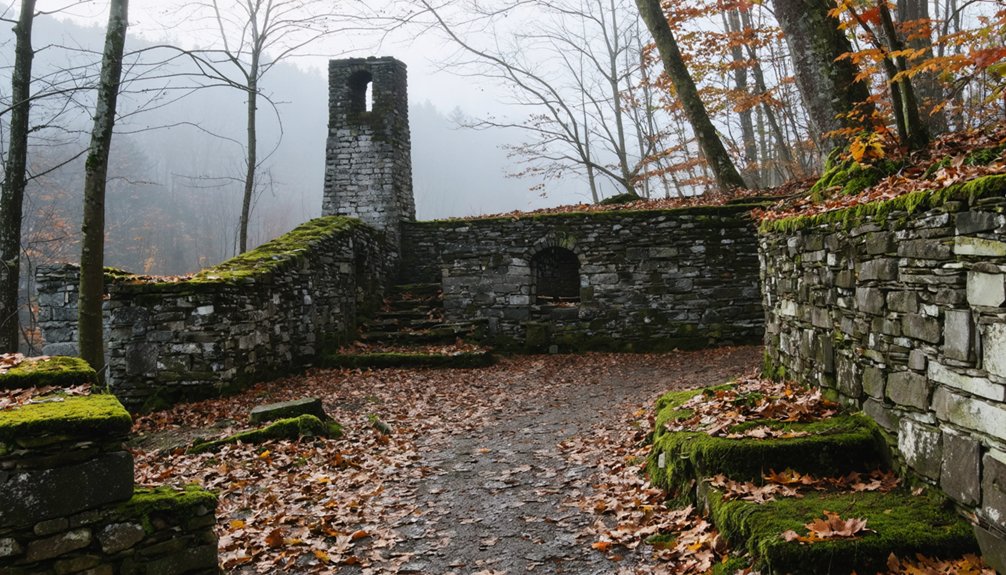
While Haunted Lake stands as Francestown’s most enigmatic natural landmark, you’ll find its mysteries deeply rooted in both fact and folklore.
In Francestown, legends intertwine with reality at Haunted Lake, where nature’s secrets whisper through the mist.
The natural formations around the shallow pond create an eerie ambiance, enhanced by birches and pines that whisper tales of centuries past.
You’ll discover three compelling features that make this area uniquely mysterious:
- The purest soapstone deposit on Earth was found here in the 1790s, transforming the landscape.
- Ancient rock formations and depressions hint at long-forgotten human structures.
- The autumnal scenery, with its vivid colors, creates a haunting backdrop that’s heightened by the pond’s natural hush.
Whether you’re exploring the old mill remnants or searching for traces of the legendary trapper’s final resting place, each natural wonder holds its own hidden story.
Frequently Asked Questions
Are There Any Remaining Soapstone Artifacts on Display in Francestown Today?
You’ll find over 100 soapstone carvings of significant historical significance at Francestown Heritage Museum, including stoves, hearths, mantels, sinks, and floors that showcase the town’s renowned soapstone craftsmanship.
What Happened to Frances Wentworth After the Town Was Named for Her?
You’ll find Frances Wentworth’s legacy remained mostly tied to the town naming significance, though historical records don’t extensively detail her later life beyond her role in New Hampshire’s colonial aristocracy.
Did Native Americans Have Legends About Haunted Lake Before Colonial Settlement?
You’ll find no specific Native legends recorded, though early Indigenous peoples avoided the haunted landscape around the lake after a devastating forest fire left it charred and spiritually unsettling to them.
How Many Original Scoby Family Descendants Still Live in Francestown?
While a million stories trace the Scoby lineage and family history through Francestown’s past, you won’t find exact numbers today – local records don’t track specific counts of original Scoby descendants still living there.
Were There Documented Paranormal Investigations at Haunted Lake in Modern Times?
You won’t find any well-documented paranormal investigations at Haunted Lake in recent times. While locals share ghost sightings and stories, there’s no verified research or formal paranormal activities from modern investigators.
References
- https://www.nhmagazine.com/francestowns-haunted-lake/
- http://sluggosghoststories.blogspot.com/2018/09/haunted-lake-aka-pond-outside-of.html
- https://www.nhpr.org/word-of-mouth/2015-10-29/haunted-hillsborough-trip-to-haunted-pond-in-francestown
- https://www.nhmagazine.com/the-many-souls-of-francestown/
- https://www.francestownnh.org/historian/pages/history-francestown
- https://archive.org/stream/historyoffrances95coch/historyoffrances95coch_djvu.txt
- https://www.nhhistory.org/object/1865252/francestown-fifty-years-of-growth-and-change-1970-2020–by-kevin-pobst
- https://books.google.com/books/about/History_of_Francestown_N_H.html?id=llGDthBQqTMC
- https://www.cowhampshireblog.com/2007/10/16/francestown-new-hampshire-is-haunted-lake-haunted/
- https://ledgertranscript.com/2019/09/18/scoby-scobie-or-haunted-solving-the-mysteries-of-francestown-s-pond-28074015/
